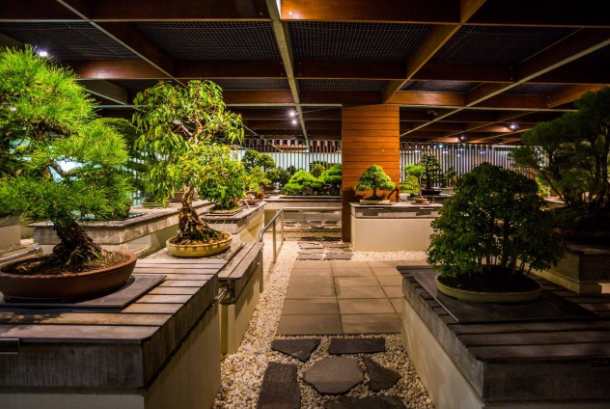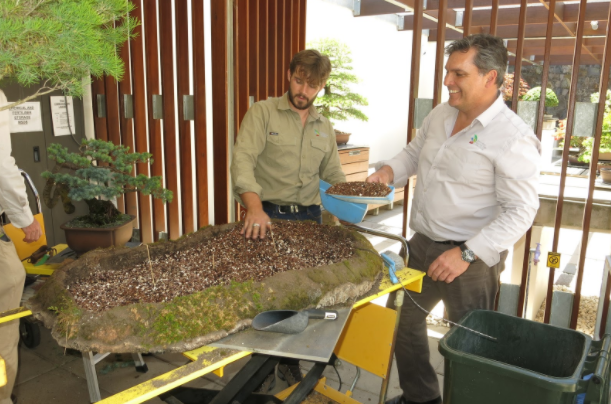Jack Sustic at NBF’s annual reception in 2018.
“It’s almost as if my life path was leading, from the very beginning, to become curator.”
Sustic has just retired from his two-year stint as National Bonsai Foundation co-president and 19 years as a board member, leaving an extensive and inspiring legacy at the Museum – including 12 cumulative years as Museum curator. Therefore, it’s only fitting we pay homage to him in our next Museum Curators spotlight.
His “path” to bonsai curator began indirectly during his youth. Sustic had heard references to bonsai in films like Karate Kid, but he first saw a real bonsai in the mid-1980s when he was serving in Korea as a U.S. Army soldier before college. He said the bonsai immediately captivated him, and upon returning to the U.S. at Fort McClellan, Alabama, Sustic joined the Alabama Bonsai Society.
The club jumpstarted his love for bonsai and plants in general, and Sustic soon graduated from Michigan State University with a degree in horticulture. He scored his first plant care job at the Riverbanks Zoo and Botanical Garden in South Carolina, during which he applied for the U.S. National Arboretum’s internship at the National Bonsai & Penjing Museum.
In 1996, Sustic served as the Museum intern for six months under Curators Bob Drechsler and Warren Hill. He returned to South Carolina after his internship wrapped up but was soon chosen for the Assistant Curator position, taking over as curator after Hill retired. Sustic served as curator from 2001 to 2005 and returned in 2008 to preside over the Museum for another eight years.
“It was such an honor to be part of that collection, but with that honor comes responsibility,” Sustic said.
Sustic and volunteer Dr. Joe Gutierrez repotting the Yamaki pine.
Accomplishments as Curator and Co-President
Sustic helped to establish many perennial programs and relationships at the Museum and NBF. He pioneered the formation of NBF’s National Bonsai Hall of Fame, which currently includes three members: John Naka, Yuji Yoshimura and Bill Valavanis.
“It was something I thought the Museum and the U.S. bonsai community needed in order to honor and recognize these bonsai masters’ valuable contributions to the art,” he said.
Sustic is credited with planting the seeds to grow the Museum’s Sister Museum relationship with the Omiya Bonsai Art Museum after he visited their site in Saitama, Japan. Sustic also formed the Consortium of Public Bonsai Curators as a way for bonsai artists and leaders to share information about how they share, cultivate and protect their bonsai collections.
“The consortium serves to help each other and each public collection. I’m very proud of that,” he said.
From left to right: Former Curators Jim Hughes, Bob Drechsler, Jack Sustic and current Curator Michael James.
Sustic’s Bonsai Inspirations
Sustic met an array of friends and teachers throughout his nearly 20 years at the Museum.
“Being curator has allowed me to get to know, work with and befriend people around the world who have been part of the Museum,” Sustic said. “The kindness that all these people share is wonderful.”
Among that company is Felix Laughlin, appointed as NBF’s third president as Sustic began his internship in 1996. Sustic eventually joined Laughlin as co-president from 2018 to 2020.
“I was really lucky to have one NBF president the entire time I was at the Museum and really lucky it was Felix,” Sustic said. “He is such a wonderful guy, and we worked really well together.”
Sustic learned the art of bonsai from many people, but he most prominently drew inspiration and learned from bonsai master John Naka, who visited the Museum every year to work on trees, especially his world-renowned “Goshin.” Sustic also visited Naka in California to work on trees in Naka’s backyard.
“Looking back now, I wish I had paid more attention,” he said. “It went by too fast, but those were wonderful experiences. I learned a lot from John, so his influence was huge on me.”
Sustic also learned from Harry Hirao and traveled to Saburo Kato’s bonsai nursery in Japan called Mansei En, during which he received one-on-one training from Kato. With their help, he excelled as a leader and friend throughout his years of dedication to the Museum.
“I distinctly remember telling Bob Drechsler, ‘I don’t know how you can be curator. I could never do it,’” Sustic said. “Fortunately, over time I learned the ropes, and eventually I took it over. I considered it a real honor and privilege to have been the steward of those trees, and I still feel that way.”
Sustic adds the final touches on a trident maple prior to an official state visit by the Japanese Prime Minister in 2012.








































